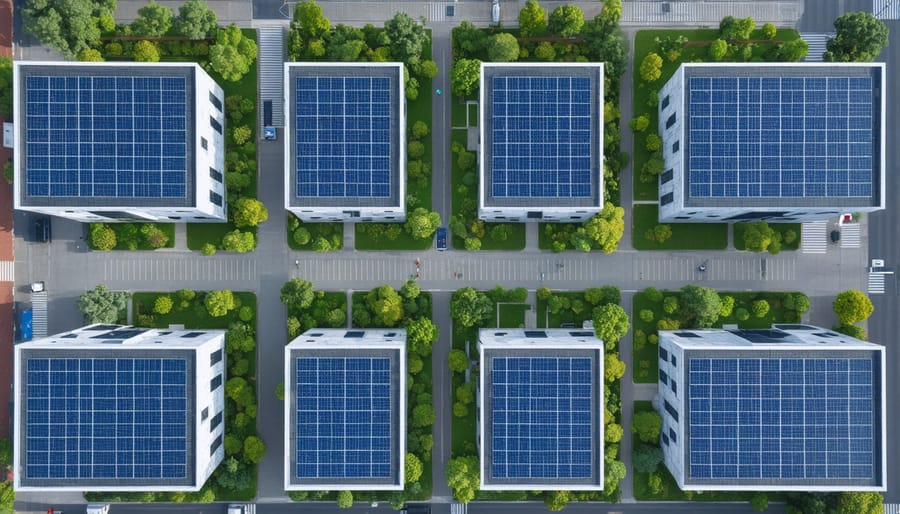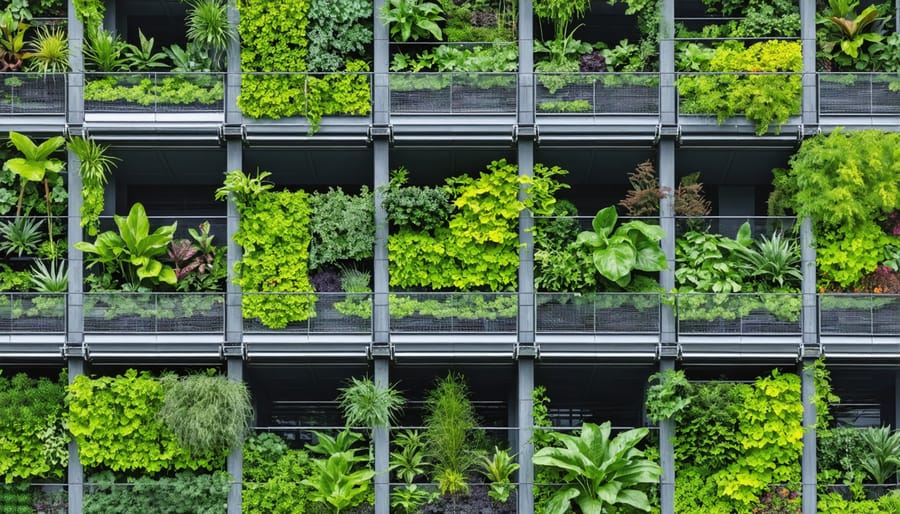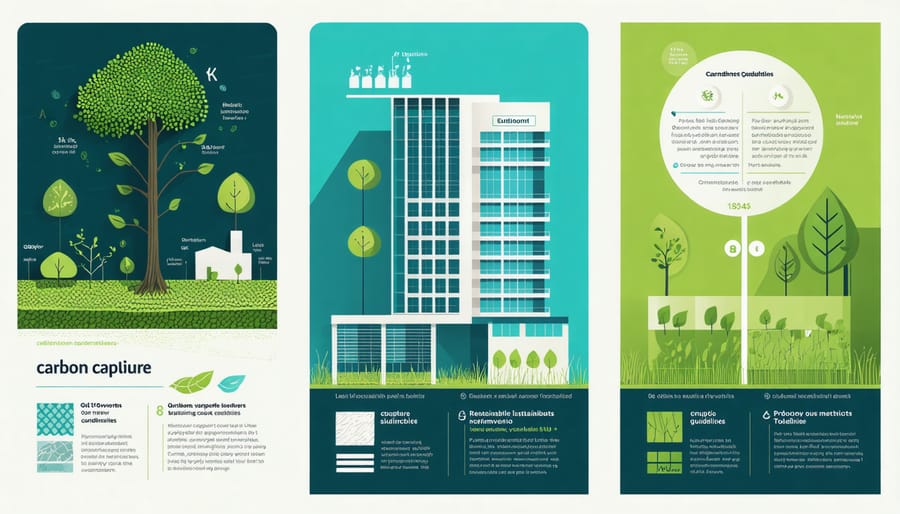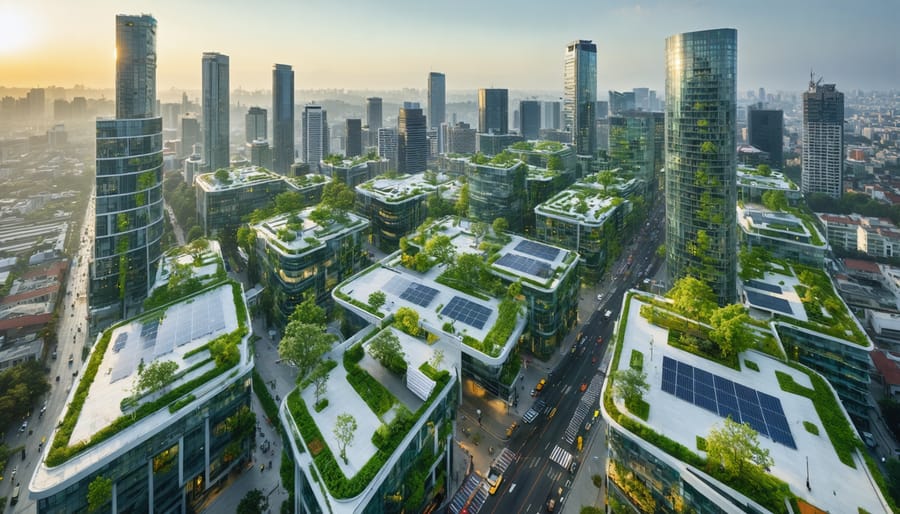Urban sustainability demands an unprecedented transformation of our built environment, with cities now responsible for 75% of global carbon emissions and 75% of resource consumption. Leading construction firms and municipalities are revolutionizing urban development through integrated solutions that merge cutting-edge technology with time-tested ecological principles.
The convergence of smart building systems, renewable energy infrastructure, and regenerative design practices has created a new paradigm for sustainable urban development. From zero-energy buildings that produce as much power as they consume to district-wide circular economy initiatives that eliminate waste, these solutions are reshaping our cities’ environmental impact while delivering measurable economic benefits.
Industry leaders recognize that urban sustainability extends beyond individual buildings to encompass entire neighborhoods and infrastructure systems. Success requires a holistic approach that addresses energy efficiency, water management, waste reduction, and human wellbeing simultaneously. Through careful integration of green infrastructure, advanced materials, and intelligent systems, today’s urban developments are achieving unprecedented levels of sustainability while creating more resilient, livable communities.
This article examines proven strategies and emerging technologies that are transforming urban sustainability from aspiration to reality, with practical insights for construction professionals seeking to implement these solutions at scale.

Intelligent Building Systems Transform Urban Efficiency
Smart Energy Management Systems
Modern urban developments are increasingly adopting intelligent energy management systems that leverage artificial intelligence and IoT sensors to optimize resource consumption. These sophisticated platforms integrate with energy-efficient building systems to create dynamic, responsive environments that automatically adjust to usage patterns and environmental conditions.
Recent implementations have demonstrated energy savings of 25-40% in commercial buildings through AI-driven optimization. These systems utilize machine learning algorithms to analyze real-time data from thousands of sensors, controlling HVAC operations, lighting systems, and power distribution with unprecedented precision. For instance, the Edge building in Amsterdam achieved a 98% efficiency rating through its smart energy management infrastructure.
The integration of predictive analytics enables these systems to anticipate peak demand periods and automatically implement load-balancing strategies. Smart meters and sub-metering solutions provide granular consumption data, allowing facility managers to identify inefficiencies and optimize operations across multiple building systems simultaneously.
Advanced visualization tools present actionable insights through intuitive dashboards, enabling rapid decision-making and system adjustments. These platforms can also integrate with renewable energy sources, managing the flow between solar panels, energy storage systems, and the grid to maximize sustainable energy utilization while minimizing costs.
As cities continue to evolve, these intelligent energy management solutions are becoming essential components of sustainable urban infrastructure, providing the foundation for more efficient, resilient, and environmentally conscious buildings.
IoT Integration for Resource Conservation
IoT integration has revolutionized urban resource management through comprehensive sensor networks and automated systems that optimize consumption patterns in real-time. Advanced sensor arrays monitor water usage, energy consumption, and waste management processes, providing detailed analytics that enable precise resource allocation and conservation strategies.
Smart building management systems utilize IoT sensors to track occupancy patterns, ambient conditions, and equipment performance. These systems automatically adjust HVAC operations, lighting levels, and water distribution based on real-time demand, reducing waste and improving efficiency by up to 30% in properly implemented installations.
The integration of weather-responsive irrigation systems with soil moisture sensors has demonstrated water savings of 40-50% in urban green spaces. Similarly, smart street lighting networks adjust illumination based on pedestrian activity and natural light levels, resulting in energy savings of up to 80% compared to traditional systems.
Real-world implementations have shown remarkable success. The Copenhagen Smart City initiative deployed over 20,000 IoT sensors across its infrastructure, achieving a 65% reduction in water waste through leak detection and predictive maintenance. Building operators can now access centralized dashboards that display resource consumption metrics, enabling data-driven decisions for sustainability improvements.
For maximum effectiveness, IoT systems should be integrated during the initial design phase of construction projects, allowing for optimal sensor placement and network architecture. This approach ensures comprehensive coverage and reliable data collection for long-term resource optimization.
Green Infrastructure Innovations
Living Architecture Solutions
Living architecture represents a critical advancement in urban sustainability, seamlessly integrating natural systems into built environments. Green roofs have emerged as particularly effective solutions, reducing urban heat island effects while providing thermal insulation that can decrease building energy consumption by 15-30%. These systems typically consist of vegetation layers, growing medium, drainage components, and waterproof membranes, designed to support diverse plant communities while protecting building integrity.
Vertical gardens, also known as living walls, maximize limited urban space by transforming vertical surfaces into productive green areas. Modern systems incorporate sophisticated irrigation and monitoring technology, ensuring optimal plant health while minimizing water consumption. Recent innovations include modular designs that facilitate installation and maintenance, making these solutions increasingly viable for large-scale commercial applications.
Bioswales represent another crucial component of living architecture, managing stormwater runoff while enhancing biodiversity. These engineered channels, featuring native vegetation and specialized soil compositions, can filter up to 90% of pollutants from surface runoff while reducing flood risks. When strategically implemented alongside green roofs and vertical gardens, bioswales create comprehensive urban water management systems.
Implementation success requires careful consideration of load-bearing capacity, irrigation systems, and plant selection. Leading projects demonstrate that maintenance costs typically decrease after the initial establishment period, while property values increase by 7-15%. For maximum impact, these solutions should be integrated early in the design phase, allowing for optimal structural support and system integration.
Recent case studies indicate that buildings incorporating multiple living architecture elements achieve superior performance metrics in both environmental impact and operational efficiency. The initial investment is typically recovered within 5-8 years through reduced energy costs, improved stormwater management, and enhanced property values.

Sustainable Water Management
Sustainable water management has emerged as a critical component of urban sustainability, with rainwater harvesting and greywater systems leading the way in resource-efficient solutions. Modern building designs increasingly incorporate these systems to reduce potable water consumption and manage stormwater runoff effectively.
Rainwater harvesting systems typically consist of collection surfaces, filtration units, storage tanks, and distribution networks. Commercial buildings can achieve 30-50% reduction in municipal water usage through properly designed harvesting systems. The collected water proves particularly valuable for non-potable applications such as irrigation, cooling towers, and toilet flushing.
Greywater systems represent another significant advancement in water conservation. These systems capture and treat water from sinks, showers, and laundry facilities for reuse in appropriate applications. Implementation requires careful consideration of local regulations, proper filtration systems, and separate plumbing infrastructure. Recent technological improvements have made these systems more compact and efficient, with advanced filtration methods ensuring safe water quality for intended uses.
Case Study: The Bullitt Center in Seattle demonstrates the effectiveness of integrated water management. Their combined rainwater-greywater system reduced potable water consumption by 82% compared to conventional buildings of similar size. The system includes a 56,000-gallon underground cistern, multi-stage filtration, and UV treatment.
Key considerations for implementation include:
– Initial site assessment and water demand analysis
– Compliance with local building codes and health regulations
– System sizing based on collection area and storage capacity
– Regular maintenance requirements
– Cost-benefit analysis incorporating long-term savings
Engineers should evaluate both immediate installation costs and long-term benefits when proposing these systems for urban development projects. Return on investment typically ranges from 3-7 years, depending on local water rates and system complexity.
Materials Revolution in Urban Construction
Next-Generation Recycled Materials
Advanced recycled construction materials are revolutionizing urban development through innovative processing technologies and enhanced performance characteristics. These next-generation materials combine sustainability with superior structural properties, offering construction professionals viable alternatives to traditional resources.
Recent developments in polymer-modified recycled concrete aggregates have achieved compressive strengths exceeding 40 MPa, matching or surpassing conventional concrete. These materials incorporate post-consumer plastics and construction waste, reducing landfill burden while maintaining rigorous industry standards.
Cross-laminated timber products manufactured from recycled wood fibers are emerging as sustainable alternatives for structural applications. Through advanced binding technologies and careful quality control, these materials offer excellent dimensional stability and fire resistance comparable to traditional engineered wood products.
Glass-polymer composites, created from processed municipal waste glass, are gaining traction in non-structural applications. These materials feature enhanced durability and reduced thermal conductivity, making them ideal for facade elements and interior partitions.
Research from the Construction Materials Innovation Center demonstrates that buildings utilizing these recycled materials can achieve up to 40% reduction in embodied carbon compared to traditional construction methods. Major projects in Seattle and Toronto have successfully implemented these materials, reporting significant cost savings over their lifecycle while meeting stringent building codes.
The integration of smart sensors within recycled materials enables real-time monitoring of structural performance, ensuring long-term reliability and safety. This technological advancement has been crucial in gaining wider acceptance among engineering professionals and regulatory bodies.
Carbon-Negative Building Solutions
Modern construction is evolving beyond carbon neutrality to actively reduce atmospheric CO2 through innovative building materials and methods. Mass timber construction, particularly using cross-laminated timber (CLT), serves as a primary carbon sequestration strategy, storing approximately 1 ton of CO2 per cubic meter of wood used while reducing embodied carbon emissions by up to 40% compared to traditional steel and concrete structures.
Biochar-enhanced concrete represents another breakthrough, incorporating agricultural waste products that permanently lock carbon within the building structure. When mixed at optimal ratios of 0.1-0.5% by weight, biochar concrete exhibits improved strength characteristics while sequestering up to 50kg of CO2 per cubic meter.
Innovative companies are developing carbon-negative concrete alternatives using industrial waste and novel curing processes. These materials absorb CO2 during the curing phase, effectively turning buildings into carbon sinks. For example, CarbonCure’s technology injects recycled CO2 into fresh concrete, reducing carbon emissions by 5-7% while improving the concrete’s strength.
Living walls and biosynthetic facades incorporate photosynthetic organisms that actively capture carbon throughout the building’s lifecycle. Recent studies indicate that well-designed living wall systems can sequester up to 1.4 kg of CO2 per square meter annually. When combined with smart maintenance systems, these solutions provide sustained carbon benefits while enhancing building aesthetics and occupant wellbeing.

Case Study: Urban Sustainability Success Stories
Copenhagen’s Nordhavn district stands as a testament to integrated urban sustainability, transforming a former industrial port into a carbon-neutral neighborhood. The project, completed in 2019, incorporates district heating systems that reduce energy consumption by 42% compared to traditional systems. Smart grid technology manages power distribution across 40,000 residential units, while green roofs cover 80% of buildings, managing stormwater and reducing the urban heat island effect.
In Singapore, the Punggol Eco-Town development demonstrates how high-density urban areas can achieve sustainability at scale. The project features solar panels generating 20% of the community’s energy needs, automated waste collection systems reducing vehicle emissions by 90%, and biophilic design elements that have increased biodiversity by 200% since implementation.
Portland, Oregon’s Lloyd EcoDistrict showcases successful public-private partnership in sustainable urban development. The district achieved LEED Platinum certification through innovative water management systems that capture and reuse 90% of stormwater, reducing municipal water consumption by 50%. The project’s green building standards have resulted in a 45% reduction in operational carbon emissions since 2015.
Vancouver’s Olympic Village, now known as False Creek, demonstrates long-term sustainability success. The neighborhood utilizes solar thermal hot water systems, providing 60% of domestic hot water needs. A unique urban agriculture program incorporates 250 community garden plots, while the district’s energy system reduces greenhouse gas emissions by 78% compared to conventional systems.
These case studies share common success factors: strong public-private partnerships, integrated technology solutions, and community engagement. Key metrics demonstrate that initial investment in sustainable infrastructure typically achieves ROI within 7-10 years through reduced operational costs and increased property values. These examples provide valuable blueprints for future urban sustainability initiatives, particularly in demonstrating the practical application of emerging technologies in real-world contexts.
As we look to the future of urban development, the implementation of sustainable solutions has moved from aspirational to imperative. The construction industry has demonstrated remarkable progress in adopting innovative technologies and practices that significantly reduce environmental impact while enhancing urban livability. The success stories from major metropolitan areas worldwide prove that sustainable urban development is not only achievable but economically viable.
Key technological advances in green building materials, smart energy systems, and waste management continue to drive the industry forward. The integration of IoT sensors, AI-powered building management systems, and renewable energy solutions has created unprecedented opportunities for optimizing resource usage and reducing carbon footprints. These innovations, combined with growing regulatory support and market demand, suggest a promising trajectory for urban sustainability.
However, challenges remain in scaling these solutions across diverse urban contexts. The construction industry must continue to invest in research and development, workforce training, and cross-sector collaboration to overcome implementation barriers. The future success of urban sustainability initiatives will depend on our ability to balance immediate economic considerations with long-term environmental benefits.
Looking ahead, we can expect to see increased adoption of circular economy principles, more sophisticated green building certification standards, and greater emphasis on climate resilience in urban planning. As construction professionals, our role in shaping sustainable cities has never been more critical or more achievable. The technologies, knowledge, and momentum are in place – now it’s time to accelerate implementation and innovation for a sustainable urban future.

